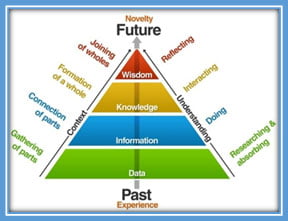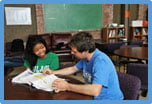Learning Commons Reflect Larger Shifts in Education
By Greg Barrett, M.Ed, REFP / Educational Planner
Libraries have been around since librarians wore togas to work. That they’ve been such a mainstay in cultures across the globe and over centuries reflects their value to society. Since then, of course, there have been monumental shifts for the library: who has access; what was kept in them; even how they are organized. After the Chinese Communist Revolution, a Dewey Decimal-like system was developed that more accurately reflected the party’s esteem towards certain subjects, placing communist theory and philosophy in the first organizational category of the Chinese Library Classification. The point being that libraries have, and still do, go through huge changes in their use and meaning, especially now that ever more resources in the traditional library evaporate into the digital realm.
Modern day America is no different, even when it comes to our most common type of library: the school library. Just as societies change aspects of their libraries to better reflect the culture, school libraries have undergone a well-documented shift in the past decade that matches changes in education. In a nutshell: libraries, like the schools around them, are becoming more student centered.
The term “student centricity” appears in many parts of the educational world; anything from curriculum design, to teaching styles, to the furniture in the room can be deemed as “student-centric”. It is maybe owed to this applicability of the term that people’s eyes can glaze over when confronted with such a vague concept. In the case of libraries, these main characteristics make the space “student-centric”:
- firstly, the space is relatively undefined until the students bring an educational need into it;
- secondly, the space is a resource to all levels of knowledge;
- thirdly, the learning commons is collaborative space that is comparable to future work environments.
Libraries that manage to include these aspects break our traditional preconceptions of libraries so much, people can barely call them by the same name. Today, we’re looking at the modern American school’s learning commons.
Giving students space and time… with no structure? There might be scarier things to some teachers, but you could probably only count them on one hand. However, saying that a space is undefined doesn’t mean it offers nothing to do. What the learning commons  offers is space for a student to come to a one-stop shop for learning, whether they have a specific educational objective or not when walking through the doors. The learning commons gives students the ability to define what the space is going to be for their current learning needs. As educators have abandoned the “filling of buckets” approach to teaching and learning for a more constructivist approach, the library is no longer the repository of knowledge, but the space in which one gathers, uses, and experiences it. Besides being a more effective way to learn, this approach also practices responsibility and self-directed learning, which is increasingly sought after by colleges and employers.
offers is space for a student to come to a one-stop shop for learning, whether they have a specific educational objective or not when walking through the doors. The learning commons gives students the ability to define what the space is going to be for their current learning needs. As educators have abandoned the “filling of buckets” approach to teaching and learning for a more constructivist approach, the library is no longer the repository of knowledge, but the space in which one gathers, uses, and experiences it. Besides being a more effective way to learn, this approach also practices responsibility and self-directed learning, which is increasingly sought after by colleges and employers.
The learning commons is not only for the acquisition of knowledge, but also for the development of knowledge, and the sharing of knowledge.
Whereas a traditional library mostly offers information, the learning commons is there not only for the acquisition of knowledge (i.e., reading and research), but also for the development of knowledge (creating a project, experimenting with materials, or conversing with peers and adults), and the sharing of knowledge (student work boards or media displays); the whole hierarchy of knowledge occurs in one place. These resources are immediately available to help the student to reach higher levels of understanding.
The knowledge hierarchy still occurs at traditional schools, with different buildings and rooms for each activity, albeit in a more disjoined way, but what’s driving the push to combine them? The answer: a more collaborative learning experience. In this environment, space is designed to connect the school community, school projects, personal interests, student-to-peer and student-to-mentor relationships, and build shared understanding. This is a space that is literally and figuratively designed for ideas to meet, resulting in new ones and a richer educational experience for everyone in that learning community.
This educational outlook isn’t just to reinforce the kinds of learning experiences that researchers say will stay with students longer, are better understood by them afterwards, and are later used by students in more scenarios. Though all of these things are true, it is also a reflection of what the workplace might look like in a future, millennial-run professional environment. This type of environment, according to millennial keynote speaker and writer, Ryan Jenkins, is to be more collaborative, more flexible in terms of how one completes the work one does, is more intrinsically valuable to the employee, and is increasingly more responsive to human needs. Some of these needs might include bringing in natural light, a stimulating environmental design, and access to food and drink.
Education has been modeled to fit our workplaces before today. After World War Two, the US and European countries revamped their educational systems in part to create the citizenry that would rebuild their badly damaged societies. In Italy, the Reggio-Emilia teaching approach, which heavily emphasizes effective, sympathetic communication in students, was a reaction to fascism’s hard-headed and heavy-handed follies. Back in the States, education was a key element in creating a productive citizenry, giving rise to our explosive economic success through the second half of the 20th century. As time continues and as new, disruptive technologies change so much in our lives, it isn’t far-fetched to think that educational experiences carry over into the adult workplace, and that educational spaces like learning commons should support future citizens as best they can now.
Whether you are convinced to call it a learning commons, an information lab, a library, or whatever you might dub it, these spaces support the shifts to the student-centered approach that we are feeling in education broadly. Though there will always be a need for organized and accessible information, we are also seeing that societies, ours included, also need to better synthesize and innovate understandings gained from information. Educators have begun addressing these needs by returning to this student-centric approach in their classrooms, and maybe it is time we thought about the same for our school libraries.
LEARNING COMMONS IN ACTION
An Imagined Trip to the Learning Commons

Pari has a science project deadline at the end of the week. She needs to present on how lithium ion batteries are produced. To start, she heads to the learning commons.
Pari can begin just by looking through the stacks, or using the high bandwidth Wi-Fi to find scholarly articles and other media to help gather information. She could print, or save these items for later reference.
Now that she has a good start with some information about lithium ion battery production, she wants to get one thing straight about the chemicals involved. The texts on the subject are overwhelming. But she sees that a science teacher has office hours in the learning commons tomorrow. She signs herself up for some time.
Pari has almost all the other information she’ll need, but isn’t sure how best to present it. A presentation board? A slide show? She takes a stroll to an area displaying other student work for inspiration. A friend’s part of a project that made a bridge of popsicles that held a computer’s weight! Though, interesting, she doesn’t think the model style suits her presentation. But a presentation program in a screen display catches her eye…
Asking the librarian, he tells her that it is a new program that he’s happy to introduce Pari to, if she has the time. She accepts, and the two go through the basics of what will later become her presentation platform for Pari’s science project.
Pari’s not sure if she’s going to keep working or call it a night, but a stop to the café joins her up with friends who chat about what they have been up to this evening. Pari’s got a lot to share.
